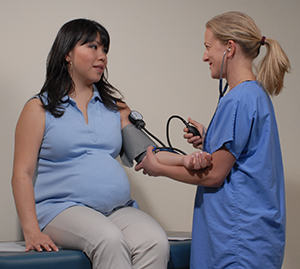Understanding Preeclampsia
Understanding Preeclampsia
Preeclampsia is pregnancy-related hypertension that develops after 20 weeks' gestation. It can lead to health risks for you and your baby. No one knows what causes preeclampsia. But it is known that the only cure is delivery.
Signs and symptoms
A common sign of preeclampsia is high blood pressure. Other signs and symptoms may include:
Rapid weight gain
Protein in your urine
Headache
Abdominal pain on your right side
Vision problems (flashes or spots)
Edema (swelling) in your face or hands (this also commonly happens near the end of normal pregnancies, even without preeclampsia)
Tests you may have
Your healthcare provider will want to check your blood pressure throughout your pregnancy. If your blood pressure is high, you may have the following tests:
Urine tests to look for protein
Blood tests to confirm preeclampsia
Fetal monitoring to ensure that your baby is healthy
Treating preeclampsia
A daily low dose of aspirin may be prescribed to those at risk for preeclampsia. Preeclampsia almost always ends soon after you give birth. Until then, your healthcare provider can help manage your condition. If your symptoms are mild, you may need bed rest at home. If your symptoms are severe, you will be hospitalized. Hospital treatment includes:
Complete bed rest to help control blood pressure
Magnesium IV (intravenous) drip during labor to prevent seizures
Induced labor or surgical delivery by cesarean section
When to call your healthcare provider
Call your healthcare provider if swelling, weight gain, or other symptoms come on quickly or are severe. Some cases of preeclampsia are more severe than others. Your signs and symptoms also may change or worsen as you get closer to your due date.
Who’s at risk?
Preeclampsia can happen in any pregnant woman. Factors that increase the risk include:
Previous pregnancies. Preeclampsia, intrauterine growth retardation (IUGR), preterm birth, placental abruption, or fetal death
Medical history of mother. Diabetes, high blood pressure, obesity, kidney disease, autoimmune disease (for example lupus), or family history of preeclampsia
Current pregnancy. First pregnancy, multiple fetuses, over the age of 40 years, or in vitro fertilization
Dangers of preeclampsia
If not treated, preeclampsia can cause problems for you and your baby. The placenta (organ that nourishes your baby) may tear away from the uterine wall. This can lead to fetal distress (the baby is at risk for health problems) and premature delivery. Preeclampsia can also cause these health problems:
Kidney failure or other organ damage
Seizures
Stroke
Once you give birth
In most cases, preeclampsia goes away on its own soon after you give birth. Within days of delivery, your blood pressure, swelling, and other signs should decrease.
Updated:
February 16, 2018
Sources:
Low-Dose Aspirin Use for the Prevention of Morbidity and Mortality From Preeclamsia: US Preventive Services Task Force Recommendation Statement. American College of Physicians, Preeclampsia: Clinical Features and Diagnosis. UptoDate, Preeclampsia: Management and Prognosis. UptoDate
Reviewed By:
Burd, Irina, MD, PhD,Goode, Paula, RN, BSN, MSN,Image reviewed by StayWell art team.
